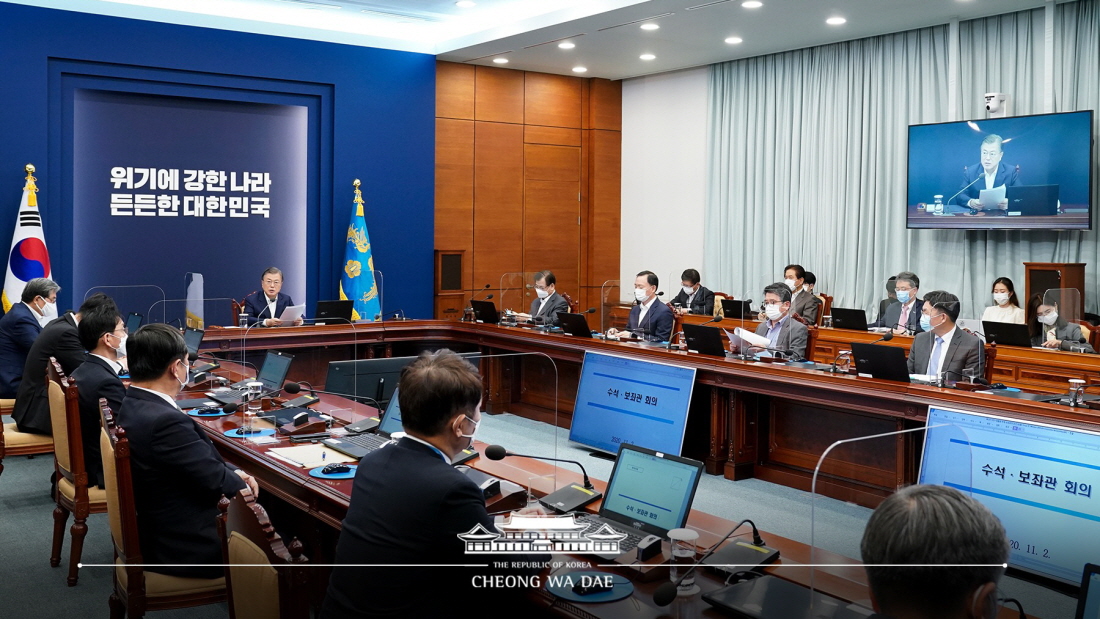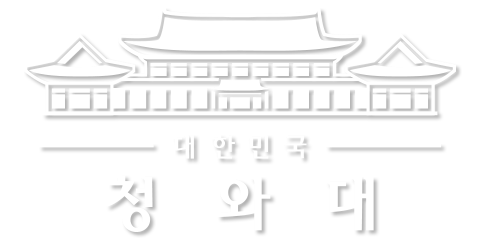이 웹사이트는 제19대 대통령 임기 종료에 따라 대통령기록관이 「대통령기록물 관리에 관한 법률」에 의해 이관받아 서비스하는 대통령기록물입니다. 자료의 열람만 가능하며 수정 · 추가 · 삭제는 불가능합니다.
다만, 「개인정보보호법」에 의하여 개인의 정보를 보호받기 원하시는 분은 관련 내용(요청자, 요청내용, 연락처, 글위치)을 대통령 웹기록물 담당자(044-211-2253)에게 요청해 주시면 신속히 검토하여 조치해 드리겠습니다. 감사합니다.
SPEECHES & REMARKS
BRIEFINGS
Opening Remarks by President Moon Jae-in at Meeting with His Senior Secretaries

Two professionals are joining today’s meeting – Incheon Medical Center Director Jo Seung-yeon and Professor Kim Yoon of Seoul National University College of Medicine. Thank you. The newly appointed Senior Secretary to the President for Jobs is also attending for the first time today. Let’s get started by giving them a round of applause.
A recent batch of economic indicators points to our economy making a quick recovery after overcoming the hardships that have arisen thus far. The third-quarter GDP growth rate has turned back into positive territory, showing the steepest upward trend in 10 years since the global financial crisis. This signifies the fact that our economy has returned to manifest growth after emerging from a sharp economic contraction that lasted for the first two quarters of this year. In particular, triple increases across the board in industrial activity – in production, consumption and investment – this September, the last month of the third quarter, further strengthen the prospect of growth continuing in the fourth quarter as well.
Economic confidence also bounced back significantly in October. The consumer confidence index and the business survey index both posted double-digit growth, the largest increases in 11 years and six months, respectively. This is the same as a green light, heralding rapid economic recovery.
The main driving force behind our economy’s rapid and robust recovery is by far increasing exports. They account for 40 percent of the Korean economy and played a pivotal role in propelling the third-quarter recovery. The export statistics for October released yesterday also show continued strength there.
The total exports by month declined slightly due to decreased working days, but daily average exports have returned to positive territory in just nine months since COVID-19 broke out in January and set a 13-month high. This precious outcome comes amid a contraction in international trade, increasing the sense that we can turn our economy around early on.
However, global economic uncertainty still remains high with France, Germany and many other countries beginning to impose lockdown measures again due to a resurgence of COVID-19. Therefore, we cannot let our guard down yet. On the domestic front, we are striving to boost domestic demand and revitalize consumption, but we cannot feel at ease as small COVID-19 infection clusters spring up continuously. In preparation for a prolonged COVID-19 pandemic, we should focus our efforts on sustainable epidemic prevention and control – befitting the time when we must coexist with the virus – for instance, by reorganizing the social distancing system. At the same time, we will have to redouble our efforts to boost economic vitality.
If these efforts are combined to extend our success fighting the virus and also a positive fourth-quarter economic trend, we will be able to see our economy recover from COVID-19’s impact and get back on the right track by the first half of next year. The Government, along with the people, will create a model economy, following our success with epidemic prevention and control.
There is a saying that one’s true nature is revealed in times of crisis. Amid the COVID-19 crisis, the true nature of the Republic of Korea – a country resilient to crises – has been rediscovered, and this has become more pronounced in the face of the recent global resurgence of COVID-19. Domestically, this crisis has served as an opportunity to rediscover our manufacturing industry. With COVID-19 limiting our movement and considerably contracting the service sector, our economy has managed to perform miraculously well thanks to our manufacturers’ brisk production and exports, made possible by our robust foundation as a manufacturing powerhouse.
October’s remarkable export figures prove that. The daily average exports of semiconductors and automobiles, Korea’s flagship products, set a record for the year. Annual biohealth-related exports have already surpassed US$10 billion for the first time in history – just from January to October. It is very significant that Korea’s daily average exports to the four major markets – the United States, China, the EU and ASEAN – all had positive growth for the first time in 25 months. This is all thanks to the leading large companies and small and mid-sized manufacturers that used exports to break through the crisis together and create opportunities. I am deeply grateful to these businesspeople and workers.
Meanwhile, we are seeing stronger investments in business ventures that will brighten the future of our country as a manufacturing powerhouse. Such investments grew as much as six percent in the third quarter year on year after rebounding from a slump in the first two quarters. This growth will serve as a reliable foundation for Korea’s leap forward into a manufacturing innovation powerhouse and provide unwavering hope for our economy.
The Government will redouble efforts to further raise our status as a manufacturing powerhouse. This COVID-19 pandemic has brought home the fact that – more than anything – we should work on what we already excel at. Last year, Japan imposed export restrictions. Nonetheless, we were able to localize production of materials, parts and equipment and used this as an opportunity to move toward becoming a manufacturing powerhouse that cannot be shaken by anyone. As such, we will learn from the COVID-19-induced economic crisis and turn this experience into an opportunity to further advance our manufacturing industries and improve their competitiveness.
The Government must redouble support to accelerate manufacturing innovation and foster state-of-the-art manufacturing, our strong suit. While doing so, we will have to devote ourselves to assisting traditional manufacturing industries, promoting mutual benefit among large companies and SMEs and supporting the nurturing of talented individuals. The Korean New Deal, which rests upon the two pillars of the Digital New Deal and the Green New Deal, will further expedite manufacturing innovation and raise the status of the Republic of Korea as a manufacturing powerhouse.



